
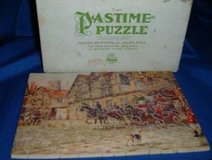 This is one of the many Parker Brothers Pastime wooden jigsaw puzzles manufactured
during the 1920's and 1930's.
According to Anne Williams in her book "The Jigsaw Puzzle - Piecing Together a History,"
these were cut by hand mostly by women workers, each of whom would incorporate various kinds of "whimsies" -
figural piece shapes - into the puzzle.
This one is called "The Mail Coach" and has about 65 pieces.
According to Anne the first jigsaw "craze" lasted from about 1907 to 1910,
followed by another during the Great Depression from 1932 to the spring of 1933.
Hand-cut wooden-backed jigsaws - particularly those containing whimsies and employing other devious tricks -
are far more interesting than the modern, mass-produced die-cut cardboard puzzles
one typically finds crowding the shelves today.
Some are very collectible, commanding hundreds or even thousands of dollars.
This is one of the many Parker Brothers Pastime wooden jigsaw puzzles manufactured
during the 1920's and 1930's.
According to Anne Williams in her book "The Jigsaw Puzzle - Piecing Together a History,"
these were cut by hand mostly by women workers, each of whom would incorporate various kinds of "whimsies" -
figural piece shapes - into the puzzle.
This one is called "The Mail Coach" and has about 65 pieces.
According to Anne the first jigsaw "craze" lasted from about 1907 to 1910,
followed by another during the Great Depression from 1932 to the spring of 1933.
Hand-cut wooden-backed jigsaws - particularly those containing whimsies and employing other devious tricks -
are far more interesting than the modern, mass-produced die-cut cardboard puzzles
one typically finds crowding the shelves today.
Some are very collectible, commanding hundreds or even thousands of dollars.
|
High-quality jigsaw puzzles can be obtained from a few companies: |
Stave has recently released affordable versions of two of their tricky designs,
Seahorse Shanty,
and Fishbowl Frenzy.
In each case, the "frame" can be assembled more than one way,
and only some or one permits the seahorses or fish to
be built inside the frame.
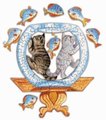
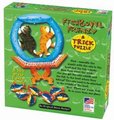
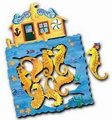
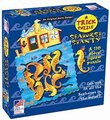
|
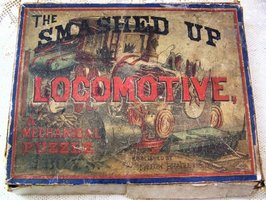

The Smashed-Up Locomotive - by Milton Bradley, from the late 1860's. One piece is missing from my copy. My copy is cut slightly differently than that pictured in Williams' book. |
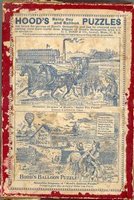
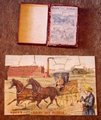
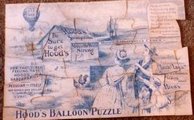

Hood's Sarsparilla Rainy Day / Balloon Puzzle - a factory and carriage scene on one side in brilliant color, and a balloon sighting on the other. I have two copies, each missing pieces. They are cut slightly differently and one cannot substitute pieces to make a single complete puzzle. |
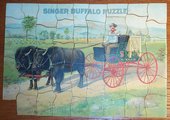
Singer Buffalo Puzzle |
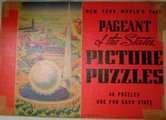
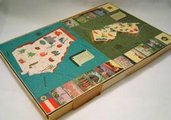
Pageant of the States |
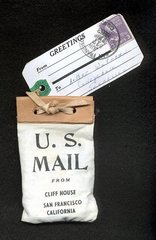
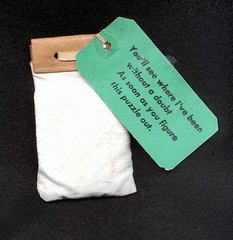
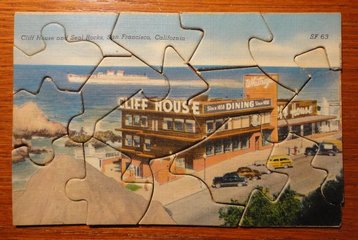
"Cliff House and Seal Rocks, San Francisco, California" A small vintage 15-piece jigsaw in a Mail Bag. |
|
The "Great Exhibition of the Works of Industry of All Nations"
(or just
"The Great Exhibition"
for short)
was based on an idea of Prince Albert's, was held in 1851 in the Crystal Palace in Hyde Park, London, and
was the first international exhibition of manufactured products.
The Crystal Palace is the icon of this fair.
I believe this vintage jigsaw puzzle is a souvenir.
It is 6" x 6" x 1/4" thick, and the lid is marked:
"The New Puzzle. Registered Industrial Exhibition - Registered According to Act of Parliament"
There is a label inside the lid, probably from a store:
"Rich d. S. Williams - No. 9 Back of Park Street - Bristol"
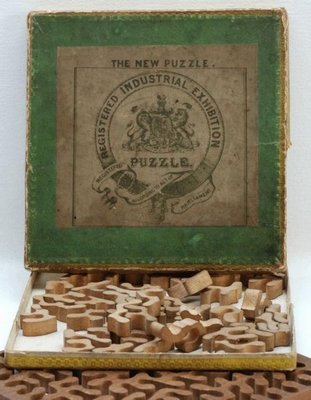
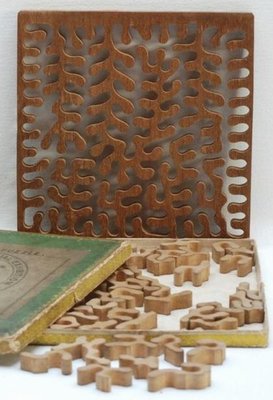
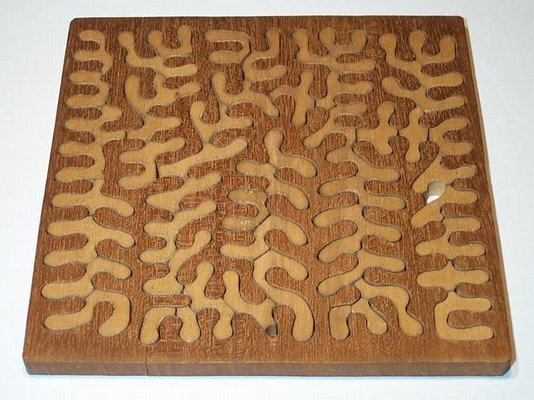
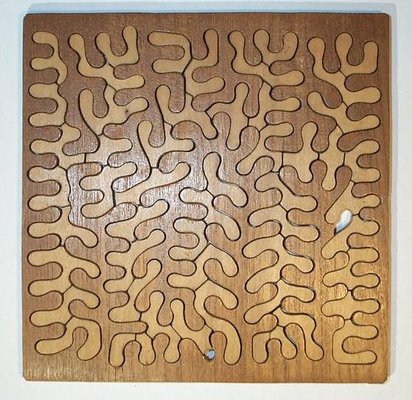
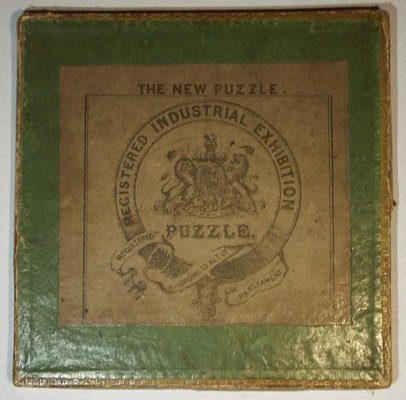
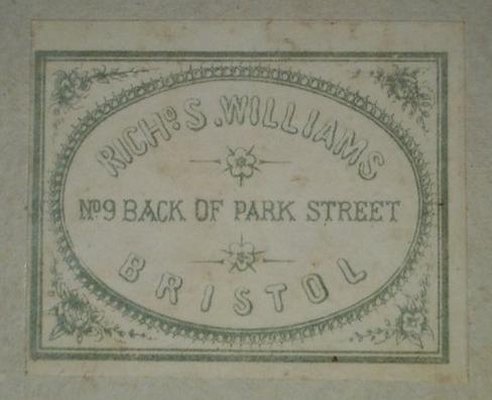
|
K Puzzle - Sprookjesvertellen - "Telling Fairytales" - 76 deelig (pieces)
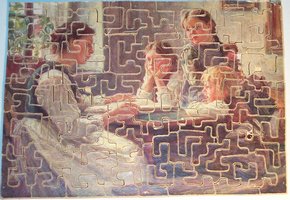
|
Another K Puzzle - a hunting scene called Op 't Spor - "On the Scent" - 84 pieces:
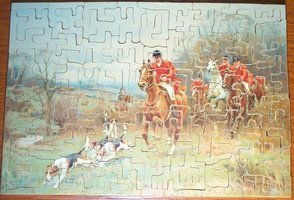
|
| "Fairytales" measures about 120x165mm assembled. Its pieces are all present and are rather strangely shaped squarish curls. There are no whimsies. Geert Bekkering, a Dutch jigsaw puzzle expert, calls this cutting style "long line angular" and says it is typical of the German brand "Schutzmarke Katharina" which started sometime between 1908 and 1910. The box paper, the art-nouveau style of the labels, the archaic spelling of "deelig" with two e's, the use of plywood with a thick inner layer, and the relatively small numbers of pieces for adult puzzles indicate that these date from prior to 1925, perhaps to the first craze of 1909. | |

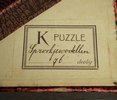
Each K puzzle came in a box of this type. |
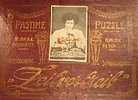
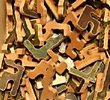
For comparison, here are examples (I don't have) of a Schutzmarke Katharina box cover and pieces. Note the picture of Katharina (the name is in red across the picture), and the piece shapes similar to those of the K Puzzles. |
One of the first puzzles I added to my collection is an original Cadaco Cluster Puzzle - #1 Animals. I discovered a website devoted to the Cluster Puzzles, run by Kelvin Palmer, the son of the original creator, Alex Palmer. From there, I was able to purchase a copy of the Smart People's Story Puzzle. In the Cluster Puzzles, the pattern is not a single picture - rather, each piece has its own figure and the pictures do not really provide a clue to assembly.
Six small puzzles were made, and one large puzzle - the Smart People's Story Puzzle, which was originally known as "The Amazing Discovery of Alec Zandimer Plerp." The website offers a Collector's Guide which contains repros of the hint sheets. At Bob Armstrong's Old Jigsaw Puzzles site I ran across a jigsaw cut before 1910 by Margaret Richardson, called "A Bad Dream," which seems to be a precursor to the Cluster Puzzles.You should also check out Daivid Bailey's World of Escher-like Tesselations and his section on Cluster Puzzles.
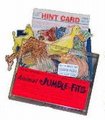 #1 Animals |
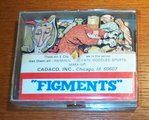
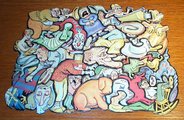 #2 Figments |
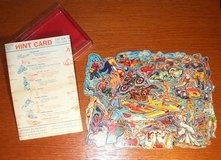
#3 Sports |
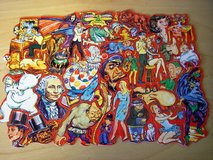
#4 Make-Up |

#5 Doodles |
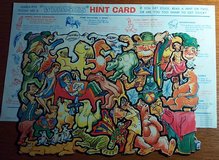
#6 Whimsies |
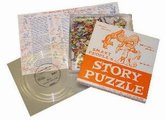
Story Puzzle |
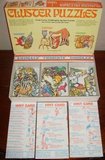 Figments, Animals, and Doodles were sold as a set in one box |
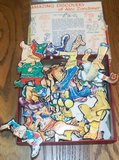
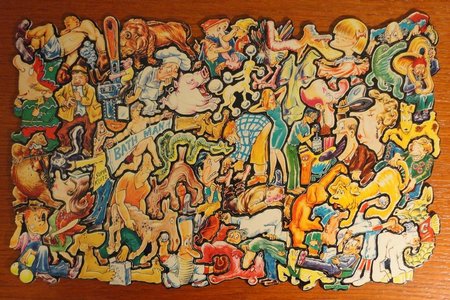
Unlikely Story #1 - The Amazing Discovery of Alec Zandimer Plerp Cluster Puzzle I have a complete copy and a copy with one piece missing. |
|||
| Alex Palmer also came up with a line of Gradual Despair puzzles. Using only 15 pieces, assemble a loop enclosing an outline of a recognizable figure. Six of these were issued by the Milton Bradley Company of Springfield Massachusetts, and came with hint sheets. The one Kelvin sent me, "Permutation Puzzle No. 1," was issued by the "Tek Method Co." of Chicago - Patents and T.M. applied for 1969. | ||||||
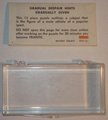
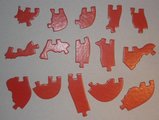
Red - 4082-D1 - Ba**** (1) |
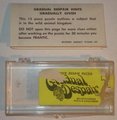
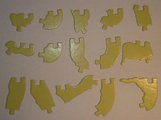
Yellow - 5660-D2 - Co**** (1) |
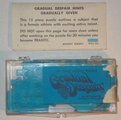
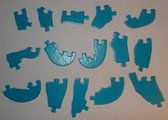
Blue - 4082-D3 - Sk**** (2) |
||||
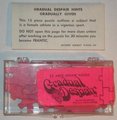
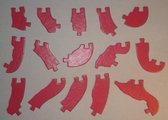
Pink - 5660-D4 - Gy***** (1) |
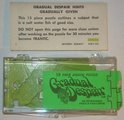
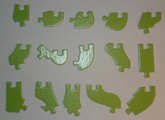
Lime - 4082-D5 - Sh*** (1) |
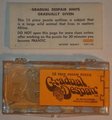
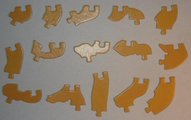
Gold - 4082-D6 - Rh*** (3) |
||||
|
||||||
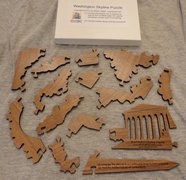 This is the
Washington Skyline puzzle,
designed, made, and exchanged at IPP32 by William Waite.
Connect the pieces to form a view of the Washington skyline. Similar to the Gradual Despair idea.
This is the
Washington Skyline puzzle,
designed, made, and exchanged at IPP32 by William Waite.
Connect the pieces to form a view of the Washington skyline. Similar to the Gradual Despair idea.
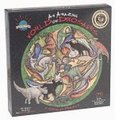
Here is a similar kind of jigsaw-type where the pieces are figures: World of Dinosaurs by Anything's Puzzable |
Another figural jigsaw, called 25 Ghosts. |
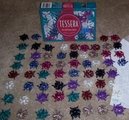
Tessera (now called "Busy Beetles" from DaMert) - 1996 designed by John Osborn. Assemble the Escher-esque interlocking beetle shapes to tile the plane. Find more Tessera info and see some patterns at "Rajordan.com." |
You can find a great deal of material on the web regarding tiling of the plane: |
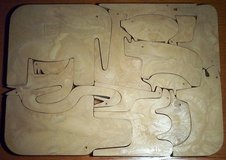
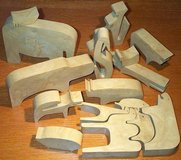

16 (Sedici) Animali by Enzo Mari. This version is made of an interesting tan plastic which has "grain" patterns and the feel and sound (when tapped) of wood. The pieces are 17mm thick and overall the puzzle measures 338x245mm when assembled. I don't have the box. The elephant piece is stamped Made in Italy Danese Milano Copyright Enzo Mari 1997. (The 7 is hard to read). I don't think this is a numbered edition. The wooden numbered edition goes for around $400. Originally issued by Danese in 1957 (produced in wood using a single cut), re-issued by Alessi in 1997. There is a companion piece (I don't have) called 16 Fish (Sedici Pesci). |
|||
"Synergistics Research Corp." (New York, New York 10011) made several jigsaw puzzles years ago. I have not found an exhaustive list, but they include:




 Others I don't have...
Others I don't have...

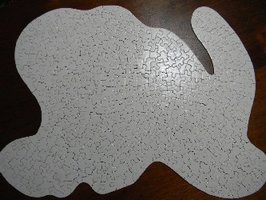



Bits and Pieces sold this very nice wooden jigsaw called Rocky Tree. |
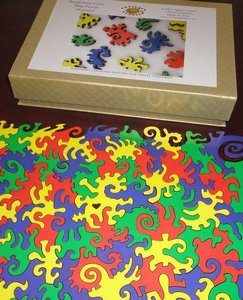 This is the Four Color Map Puzzle, from
Artifact Puzzles.
It is laser-cut from 1/4" wood, has 68 pieces, and is 6" x 8" when completed.
The puzzle is attractive - nicely made and brightly colored.
Each piece is monochromatic - either green, yellow, red, or blue.
The pieces were designed by Seattle artist Tara Flannery, who has designed
several other puzzles for Artifact.
The cutting style was inspired by
John Stokes III, and while this
puzzle has no "whimsy" pieces per se, all the cuts are so intricate that each piece is a tiny work of art.
Using
Bob Armstrong's classification method, I'd say this type is interlocking (of course),
with curl knobs, 1:1 contour lines, a scroll pattern, and irregular edges -
and to me, it looks like a map of
someplace out of
Dr. Seuss!
In the completed puzzle, no adjacent pieces have the same color.
This puzzle is of special interest because it incorporates the idea of a famous mathematics/graph-theory problem called the
Four Color Theorem, which holds
that any set of contiguous (touching) regions on a plane, no matter how convoluted their boundaries, can be colored such that no adjacent regions are the same color, using no more than four colors.
(Regions that meet only at a point are not adjacent.)
Although it was proven as far back as in 1890 that
no more than five colors are needed, proving that only four suffice was very difficult and was only
accomplished in 1976, by Kenneth Appel and Wolfgang Haken, using a computer.
Artifact Puzzles' Four Color Map Puzzle has been favourably reviewed by several puzzle bloggers, including
Brian,
Neil,
and
Allard.
I had fun with it, too - it took me about an hour to complete. I found the no-adjacent-pieces-the-same-color rule helpful (colorblind puzzlers will be more challenged).
This is the Four Color Map Puzzle, from
Artifact Puzzles.
It is laser-cut from 1/4" wood, has 68 pieces, and is 6" x 8" when completed.
The puzzle is attractive - nicely made and brightly colored.
Each piece is monochromatic - either green, yellow, red, or blue.
The pieces were designed by Seattle artist Tara Flannery, who has designed
several other puzzles for Artifact.
The cutting style was inspired by
John Stokes III, and while this
puzzle has no "whimsy" pieces per se, all the cuts are so intricate that each piece is a tiny work of art.
Using
Bob Armstrong's classification method, I'd say this type is interlocking (of course),
with curl knobs, 1:1 contour lines, a scroll pattern, and irregular edges -
and to me, it looks like a map of
someplace out of
Dr. Seuss!
In the completed puzzle, no adjacent pieces have the same color.
This puzzle is of special interest because it incorporates the idea of a famous mathematics/graph-theory problem called the
Four Color Theorem, which holds
that any set of contiguous (touching) regions on a plane, no matter how convoluted their boundaries, can be colored such that no adjacent regions are the same color, using no more than four colors.
(Regions that meet only at a point are not adjacent.)
Although it was proven as far back as in 1890 that
no more than five colors are needed, proving that only four suffice was very difficult and was only
accomplished in 1976, by Kenneth Appel and Wolfgang Haken, using a computer.
Artifact Puzzles' Four Color Map Puzzle has been favourably reviewed by several puzzle bloggers, including
Brian,
Neil,
and
Allard.
I had fun with it, too - it took me about an hour to complete. I found the no-adjacent-pieces-the-same-color rule helpful (colorblind puzzlers will be more challenged).
|

A 17-piece jigsaw puzzle cut from a dollar coin, from Coin Cut Art by "Grinan" I chose a 2000 Sacagawea Gold dollar coin. Grinan uses a steel blade only .002" thick. "Numismatic Jigsaw Puzzles" is an original idea of Jeremy Barrett and copyright of Coin Cut Art. |
|

This four-piece plastic puzzle is called Oskar's Fractiles. It was designed by Oskar van Deventer. Find a way to insert the three identical yellow pieces into the black piece and form a symmetric assembly. |
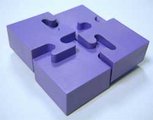
This simple 4-piece jigsaw from Binary Arts is ingenious. This design has appeared in many guises, in wood as well as metal (see the Hanayama "Spiral" for example). |
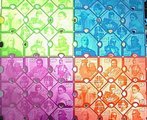
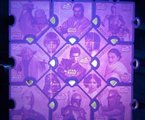
This 9-piece jigsaw-like assembly with a (licensed) Star-Wars theme is a Frito Lay premium, and is part of a larger collection of four such assemblies in different colors. Each piece contains an image and image fragments of neighboring pieces. The images have a 3D effect, and when held up to the light, the images are strikingly clear. |
|
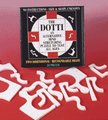
The Dotti Puzzle - made in Merton Devon England by Active Education, distributed by Gazebo Games (wholesale only - requires id/password) - fundemental.biz has it - it's positioned as a workplace management training tool. 24 white pieces with no instructions or solutions, but the box claims it forms a "solid recognisable shape when completed." The box cautions one to "clear the mind completely" and "make no assumptions," and claims that "each piece has blue dots on one side and red on the other." I suppose one's assumptions are supposed to be an impediment to solving this puzzle, but it didn't really seem that hard. Perhaps some sloppy piece-cutting gave away the game for me. |
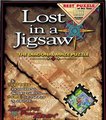

The "Diagonal Maze" puzzles Lost in a Jigsaw - Escape from Eden, and Lost in a Jigsaw II - Survival of the Fittest were issued by Buffalo Games, Inc. (BGI) in 1997 and 2001 respectively. They are based on one of the ideas covered in Donald Scott's 1994 U.S. patent 5351957 - which says, "correct placement ... is determined from information available only in the sum of all the correctly assembled [clusters]." Clusters of pieces are assembled into squares which can then be joined in multiple positions. The correct position for each cluster must be determined by figuring out the clues offered in the illustrations revealed on the completed clusters. Games Magazine had voted Escape from Eden the "Best Puzzle of the Year." |
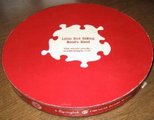
This jigsaw is in the shape of a circle and has over 500 pieces. It is called "Little Red Riding Hood's Hood" and is solid red in color. Way back in my college years, I assembled one of these with the help of my girlfriend of the time. Man, was it tedious! But we were determined, and eventually completed it. I think we then shellaced it, and that copy is long gone. Springbok also made an all-white version called Snow White Without the Seven Dwarves, an all-brown one called Close-up of the Three Bears, an all-blue one called Little Boy Blue Coming Home, and a reflective-surfaced version called Enchantment. You can see these and other Springbok jigsaws at Mike Helland's Spingbok Fever site, and at "Courtney's" site. |
|
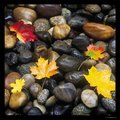
This is a "Shmuzzle Puzzle" called "On the Rocks." All the pieces are the same shape - interlocking lizards a la Escher. |
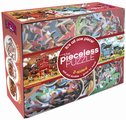
A Pieceless Puzzle from Ceaco. |
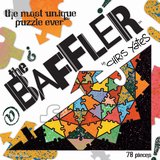
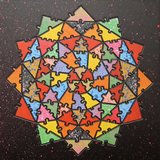
Bindu Truss - one in a series of "Baffler" puzzles designed by Chris Yates and issued by Ceaco. Thanks, Brett! |
|
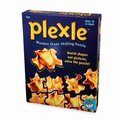
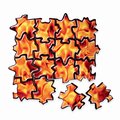

Some puzzles from the interesting Plexle series of 16-piece jigsaws with wooden pieces, from Mindware - Fire, Water, and Space |


This is Squarewave Remodulator, a difficult jigsaw in the Baffler series two from Brainwright. It was designed by Chris Yates. It has only 66 pieces, but its border is convoluted and it has no image to aid in construction. You must go by piece shape alone - each piece is unique. |
||
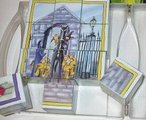
Another style of puzzle is a set of cubes where each of a block's six faces contributes a part of six different pictures that can be formed. This set of scenes from the "Madeline" books is a good puzzle for children. This puzzle presents one nice challenge based on violating a preconception. Changeable Charlie (try Changeable Charlie online), first produced in the 1940's, is a classic toy similar to this type of puzzle. I had one as a child. It's not really a puzzle, since the blocks are meant to form many different pictures from component features. It was based on an earlier design called "Ole Million Face" created in 1925 by cartoonist Carey Orr. At Judy's Old Wood Toys website, I learned that Changeable Charlie was produced by the Gaston Manufacturing Co. of Cincinnati OH, which was acquired by Halsam Products Co., who also acquired the Embossing Company in 1955, and who were in turn acquired by Playskool in 1962. Playskool was purchased by the Milton Bradley Co., which sold itself to Hasbro. There was also a Changeable Charlie's Aunt. |
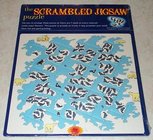
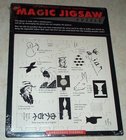
Two unusual jigsaw puzzles, both designed by Dugald Keith, Copyright 1998, and issued by Blue Opal Australia under license from Crystal Lines International. The Scrambled Jigsaw - Icy Logic consists of nine plus-sign-shaped pieces that must be arranged in the frame such that there are seven seals on each iceberg. The Magic Jigsaw - Ambiguous Figures consists of a set of pieces that, arranged one way, have a gap, and arranged another way no gap. |
||
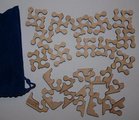
Swiss Cheese by George Miller. |

Cliff Hangers, a challenging 1000-piece jigsaw puzzle from Springbok. This one captures a scene with beautiful and subtle colors, and has been fun for the family to assemble. Springbok puzzles employ special dies and no two pieces in a puzzle are identically shaped. Springbok was founded in 1963, acquired by Hallmark in 1967, and as of 2002 Springbok puzzles are produced by Allied Products. You can read more about Springbok's history at their website. Thanks, Paxton! |
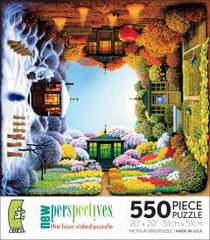
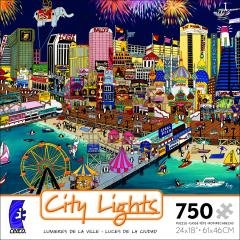
Here are Four Seasons and Atlantic City, 550 and 750 piece traditional jigsaw puzzles, each with colorful and interesting scenes. I received these nice puzzles from Ms. Alison Yada at Ceaco. Thanks, Alison! Ceaco is the largest U.S. jigsaw puzzle manufacturer. They also offer a line of games, under their Gamewright brand, and a line of brainteasers, under their Brainwright brand. |
|
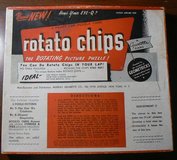
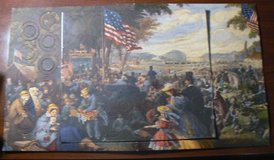
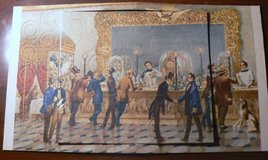
A vintage Rotato Chips Puzzle by Grumette |
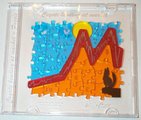
Coyote Howling at the Market by Jurg von Kaenel |
||
 Some of the first 3-dimensional jigsaws were dissected spheres such as this one. |

The Wonder Block A block of wood cut into nesting tables and chairs has appeared often. |
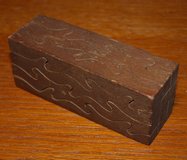
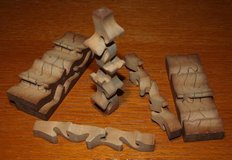
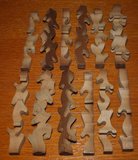
12 sticks Received as part of an auction lot. I don't know the provenance. |
|

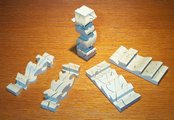
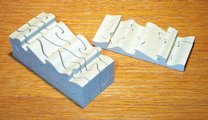
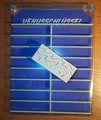
My Dad sent me this VenusSchlussel (Venus Key) from the Lilliput Motor Company (they don't seem to carry it any more, though). It's got 16 sticks. |
|
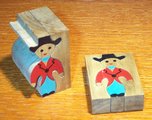
I got this cowboy from auction. |
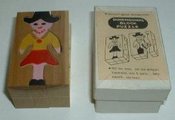
I believe his mate is this cowgirl (which I do not have). |
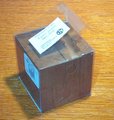
 I have 8-pc. and 27-pc. Flummox Cubes, bought years ago at Games of Berkeley in California. |
 This is a square-cross-section stick that has been sawn into interlocking pieces. The stick is very flexible, and rests in a stand. |
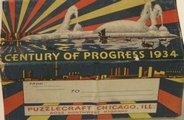
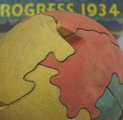 Century of Progress 1934 - Sphere made by Puzzlecraft of Chicago IL. |
 This is called "A Broken Heart - a 3-Dimension Technisolid Puzzle" and it was "designed and made only by Puzzle Guild, Inc., Chicago." |
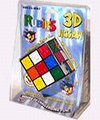
Rubik's calls this their "3-D Jigsaw." Assemble jigsaw pieces on the surface of a cube. |

This wooden apple is from the Pacific Puzzle Company. |
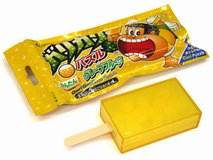
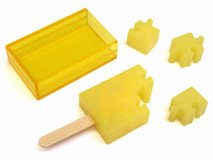
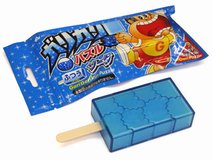
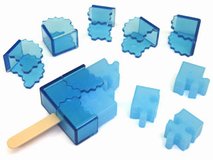
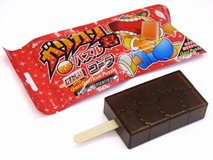

A set of three assembly puzzles from Japan - Garigari Grapefruit (easy), and Garigari Soda (normal), Garigari Cola (hard) Made in China and distributed by Hanayama |
|

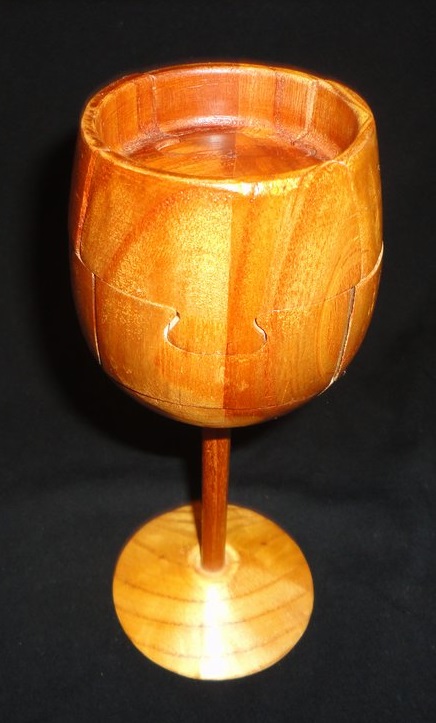
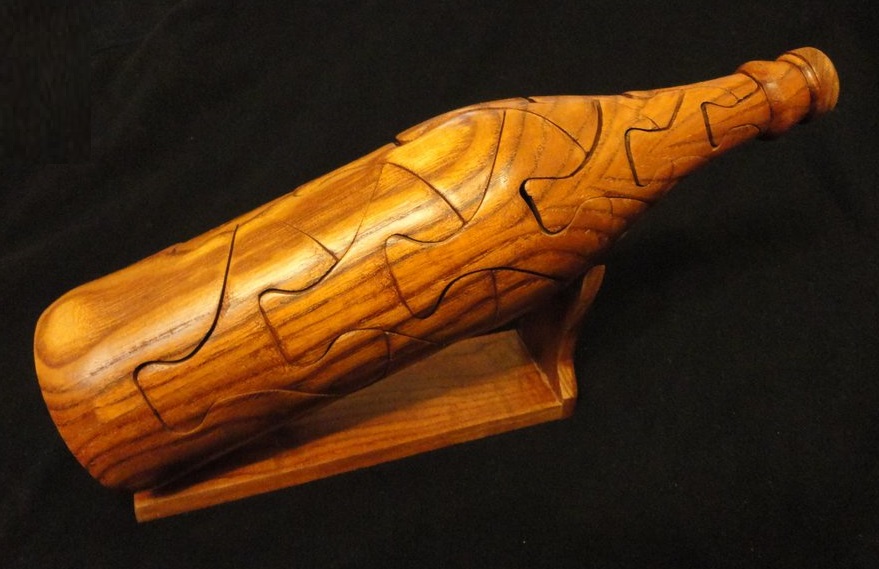
3D Jigsaw Teacup, Wine Glass, and Wine Bottle These were included in a group of puzzles I purchased on auction. Each has a removable pin lock, and directional cuts. |
|
The Scrambled Egg also came in a smaller size called Bantam Eggs. I have a red one and a blue one, with their smaller boxes.
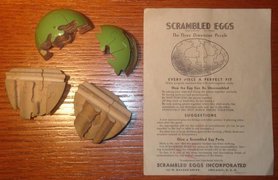
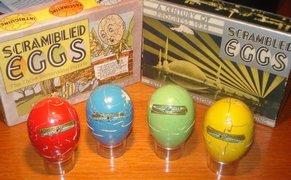

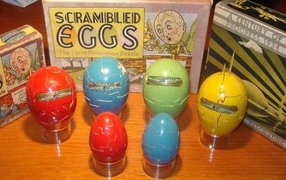
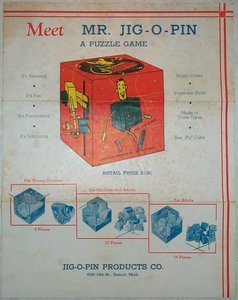
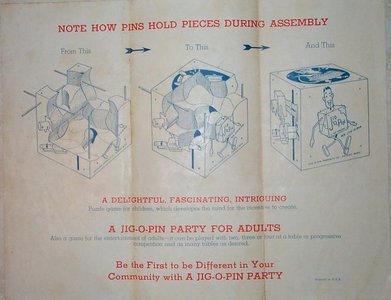
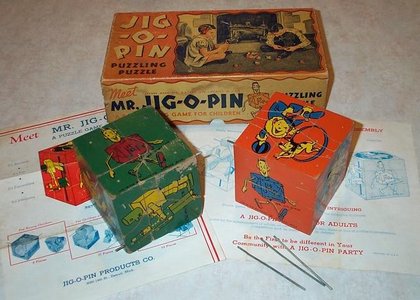
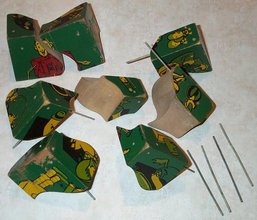
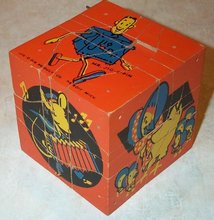
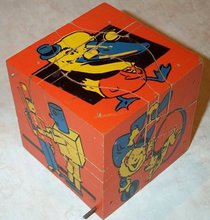


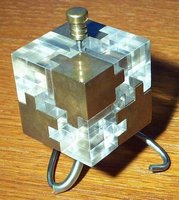

It's hefty and beautiful, and a part of mechanical puzzle history. Rocky tells the story of how he got into making mechanical puzzles from brass on his website. Thanks again, Rocky!
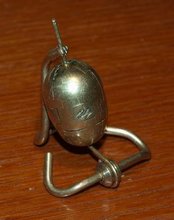
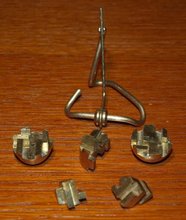
A Good Egg - Rocky Chiaro |
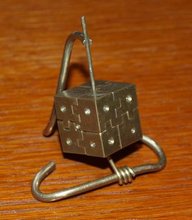
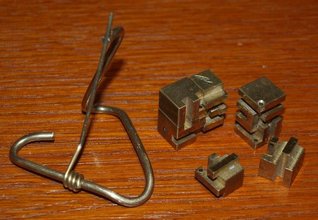
D-Ice - Rocky Chiaro |
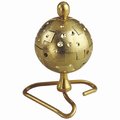
Bits and Pieces offered this affordable version of T-Dof by Rocky Chiaro. It's a brass golf ball in eight pieces, held together by the spindle when assembled. |
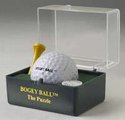
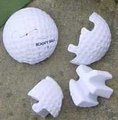
The Bogey Ball is a plastic golf ball divided into eight interlocking pieces. Where the T-Dof's pieces have rectilinear flanges that don't really grip each other, the flanges on the pieces of the Bogey Ball have a more traditional jigsaw-type fit. |
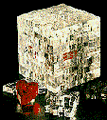
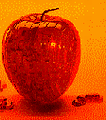
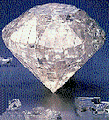

Jeruel also offered a set of 3D Crystal Puzzles.
There are many different 3D animals made of interlocking plastic pieces - here are the examples I've got:
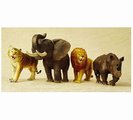
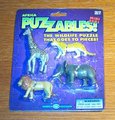

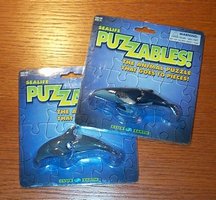
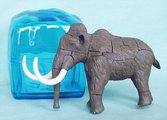
|


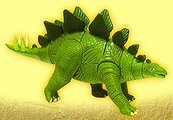
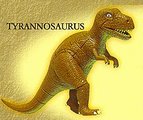

|
There have been several puzzles where a block of wood has been sliced using two perpendicular sets of parallel wavy cuts to form a bundle of wavy sticks that must be re-fit together to make a block. The cuts range from simple to intricate.
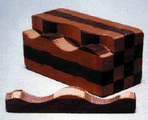 Sweet Sixteen from Mossy Creek (Gift from Brett) |
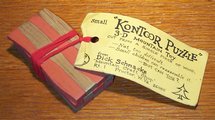 Kontoor |
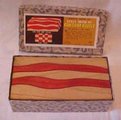 This is the Crazy Mixed Up Contour Puzzle, made in Taiwan for Shackman. |
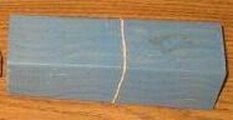 5x5 blue bundle (from Steve Merritt collection) |

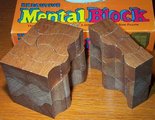
This is the Executive Mental Block puzzle by Benjor. A mahogany cube has been sliced up into a 3x3x4 assembly, but the pieces do not interlock. |
|||